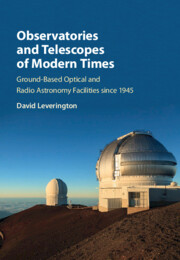 Observatories and Telescopes of Modern Times
Observatories and Telescopes of Modern Times from Part 2 - Radio Observatories
Published online by Cambridge University Press: 15 December 2016
ALMA
As mentioned previously (see Section 20.8) the NRAO had been trying in the late 1970s to get funding for a new 25 m (82 ft) millimeter-wave radio telescope to be built on Mauna Kea, but this had been killed off in 1982 by the Astronomy Advisory Committee. However, in the same year, an internal NRAO proposal was made to build a VLA-type millimetre array of fifteen 10 m diameter dishes on 1 km long arms. The plan was to build it near the VLA(1) at an altitude of about 2,100 m (6,900 ft) on the Plains of San Augustin, New Mexico. A little later, higher sites were considered in Arizona and New Mexico to enable the telescope to operate down to a wavelength of at least 0.85 mm (frequency 350 GHz). Then in 1990 the NRAO proposed what was called the Millimeter Array (MMA) which was to consist of forty 8 m diameter dishes, with a total area of 2,000 m2, at a cost of at least $120 million.(2) It would operate in the wavelength range from 10 mm to 0.35 mm (frequencies 30 GHz to 850 GHz)(3) and be built on a site about 3 km in diameter at an altitude of about 2,500 m (8,200 ft) in Arizona. At this stage the NSF, the potential funding source, let it be known that they expected that any large project of this nature should involve a number of international partners. By the mid 1990s, the NRAO were considering much higher sites on Mauna Kea or on Llano de Chajnantor at an altitude of about 5,000 m (16,400 ft) in the Atacama Desert to enable the array to operate well into the submillimetre range.
In Japan, meanwhile, the Tokyo Astronomical Observatory had built the Nobeyama Millimeter Array in the 1980s (see Section 23.5) which consisted of a number of 10 m dishes operating down to 0.8 mm. They followed this with plans to build an array in northern Chile consisting of fifty 8 m or 10 m diameter dishes called the Large Millimeter and Submillimeter Array (LMSA) to operate down to 0.35 mm.
To save this book to your Kindle, first ensure [email protected] is added to your Approved Personal Document E-mail List under your Personal Document Settings on the Manage Your Content and Devices page of your Amazon account. Then enter the ‘name’ part of your Kindle email address below. Find out more about saving to your Kindle.
Note you can select to save to either the @free.kindle.com or @kindle.com variations. ‘@free.kindle.com’ emails are free but can only be saved to your device when it is connected to wi-fi. ‘@kindle.com’ emails can be delivered even when you are not connected to wi-fi, but note that service fees apply.
Find out more about the Kindle Personal Document Service.
To save content items to your account, please confirm that you agree to abide by our usage policies. If this is the first time you use this feature, you will be asked to authorise Cambridge Core to connect with your account. Find out more about saving content to Dropbox.
To save content items to your account, please confirm that you agree to abide by our usage policies. If this is the first time you use this feature, you will be asked to authorise Cambridge Core to connect with your account. Find out more about saving content to Google Drive.